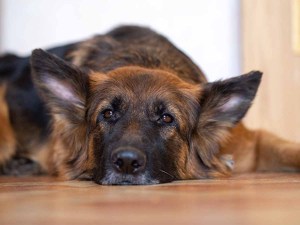Urinary incontinence is a house-trained dog or a litter box-trained cat losing control of its bladder. Incontinence can affect pets of any gender, age, or breed, but females have a higher occurrence, and some of the following dog breeds are prone to it1,2:
● Cocker spaniels
● Springer spaniels
● Doberman pinschers
● Old English sheepdogs
● Boxers
● German shepherds
● Giant schnauzers
● Irish setters
● Rottweilers
● Weimaraners
Incontinence should not be confused with house-training challenges or submissive urination (“stress incontinence”). (Stress incontinence, which can happen in young dogs, follows the normal biological voiding process.)3
Possible causes of urinary incontinence in dogs include1,4
● Imbalance of hormones
● Urethral sphincter weakness
● Spinal cord injury or protruding intervertebral disc
● Congenital abnormalities
● Obesity
● Prostate disorders
Common signs of urinary incontinence include1:
● Dripping urine, or involuntary loss of urine
● Wet hair or inflammation of the skin around the genitals
● Licking of the vulva or penis area
● Urine spot where your pet sleeps
● Some additional signs of urinary incontinence in female dogs include discomfort or behavioral changes, scalding of the skin or severe eczema, and (in severe cases) an offensive odor.
Hormone-related incontinence3
In middle-aged to older spayed females, a hormonal imbalance can cause incontinence. One out of 5 spayed female dogs can be affected by incontinence, which usually develops about 3 years after the surgery.5 About 30% of female dogs that develop urinary incontinence also weigh more than 45 lbs.6
It is seen less frequently, but is also possible, in young females and older neutered males. Hormonal incontinence is caused by a deficiency of estrogen (in females) or testosterone (in males). Both of these hormones are important in maintaining muscle tone of the urethral sphincter.
Hormone therapy, such as INCURIN®Tablets (estriol), can help control estrogen-responsive urinary incontinence in spayed female dogs.
Urethral muscle-related incontinece1
Some treatments and surgeries, or collagen injections can help strengthen the urethral muscles that control your pet’s flow of urine. Phenylpropanolamine can also be used to treat poor muscle tone in the urethral sphincter in dogs.
Spinal cord incontinence1
Your veterinarian may recommend surgery for a protruding disc.
Congenital abnormalities1
Your veterinarian may recommend surgery to correct any congenital abnormalities that are causing urinary incontinence in your pet.
References:
1. Urinary incontinence. ASPCA. https://www.aspca.org/pet-care/dog-care/common-dog-behavior-issues/behavior-problems-older-dogs
2. Holt PE. Urinary incontinence in the bitch due to sphincter mechanism incompetence: prevalence in referred dogs and retrospective analysis of sixty cases. J Small Anim Pract. 1985;26(4):181-190.
3. Urinary incontinence and bladder problems in dogs. WebMD. http://pets.webmd.com/dogs/dog-urinary-incontinence-and-bladder-problems
4. Lack of bladder control in dogs. PetMD. http://www.petmd.com/dog/conditions/urinary/c_multi_incontinence_urinary
5. Ettinger SJ, Feldman EC, eds. Textbook of Veterinary Internal Medicine: Diseases of the Dog and Cat. 7th ed. St. Louis, MO: Saunders Elsevier; 2010:162, 1905.
6. Holt PE. Urological Disorders of the Dog & Cat-Investigation Diagnosis and Treatment. London: Manson Publishing; 2008:150.
Important Safety Information:
Evaluation of factors contributing to urinary incontinence should be considered prior to administration of INCURIN Tablets. Do not use with other estrogens. The concomitant use of INCURIN Tablets with other estrogens or with glucocorticoids has not been evaluated. The safe use of INCURIN® Tablets has not been evaluated in intact female dogs, pregnant or lactating dogs, male dogs, dogs less than 1 year of age, or dogs with liver disease. Reported adverse reactions include anorexia, emesis, polydipsia, and swollen vulva. Not for human use. Keep out of the reach of children. Women who are of childbearing age or those who are breastfeeding should use caution when administering INCURIN Tablets. Wash your hands with soap and water after administration to avoid exposure to the drug. For complete safety information, refer to the product label.
Want to share this article?
More like this
September is dog tick season
The weather is beautiful, fall is just around the corner … and it’s peak season for ticks.
Tick talk
Use our tick identifier to select a tick and learn about what it looks like, where it lives, and what risks it might pose to your pet.
Caring for a senior pet
Cats and dogs may need special attention as they age, so it helps to understand what to expect as your pet gets older.




